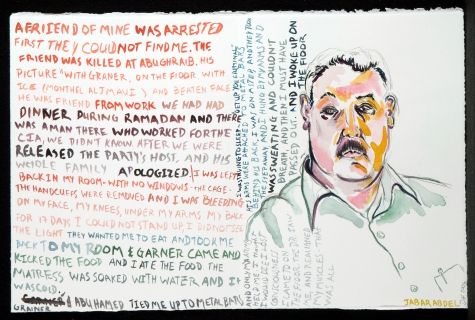“The friend was killed at Abu Ghraib. His picture with Graner, on the floor with ice and beaten face. He was friend from work.”
– Jabar Abdel, former Abu Ghraib detainee, quoted in A Friend of Mine Was Arrested (below), by Daniel Heyman

Anyone that has made analysis of the photographs of Abu Ghraib should also be aware of Daniel Heyman‘s paintings Portraits of Iraqis.
Heyman made the watercolours and sketches while sitting in on interviews between former Abu Ghraib detainees and Susan Burke, a human rights lawyer with Burke O’Neil LLC, Philadelphia. Burke was looking to bring in artists and writers to tell the stories of her clients in different ways and to reach a wider audience. (Simultaneously, photographer Chris Bartlett was also working on portraits for his Detainee Project.)
Heyman had previously used facsimiles of the Abu Ghraib pictures in his mixed-media and woodblock artworks, but had become discouraged by the laziness of the appropriation:
“The potency of those images really diminished. All sorts of artists had started to use these images, and the more they were used, the more they indicated Abu Ghraib without providing any understanding of Abu Ghraib. They became a kind of code for anger about so many things to do with the war. You flash on the famous picture of the man on the box, and people become numb to that image. And you re-humiliate that man. You re-victimize that person.”
I recently saw three of Heyman’s works in a gallery; they are the perfect foil to those infamous images of Abu Ghraib. In December 2008, upon reflection of Standard Operating Procedure, Errol Morris’ film that gave the US soldiers a voice against the military brass, I suggested, “what the global community needs now is an equally comprehensive documentary project bringing together the testimonies of all those held and tortured at Abu Ghraib.”
There have been articles written, lawsuits brought, oral testimonies made – but Heyman’s work stands out as a particularly successful enterprise. Heyman makes the paintings and records the words in real time as the interview goes on. A slightly grueling process about a horrifically grueling topic. Heyman brings us very close to these victims of torture; they are no longer the abstractions we’ve known through the Abu Ghraib files, but individuals with the knowledge and details of fact that should shake our conscience.
In consideration of the broad range of artists’ responses (from good to bad) to the Abu Ghraib images of torture, for me, Daniel Heyman’s paintings carry an impact far beyond that within the capabilities of most photography.
Read Heyman’s interview with Foreign Policy in Focus.
View Heyman’s website.
SmithMag has an easy-to-navigate gallery.




1 comment
Comments feed for this article
April 24, 2011 at 7:43 am
Sunday Reading, sans rhyme, sans reason « zunguzungu
[…] Prison Photography, Daniel Heyman’s paintings Portraits of Iraqis are remarkable: I am an artist who by a stroke of […]